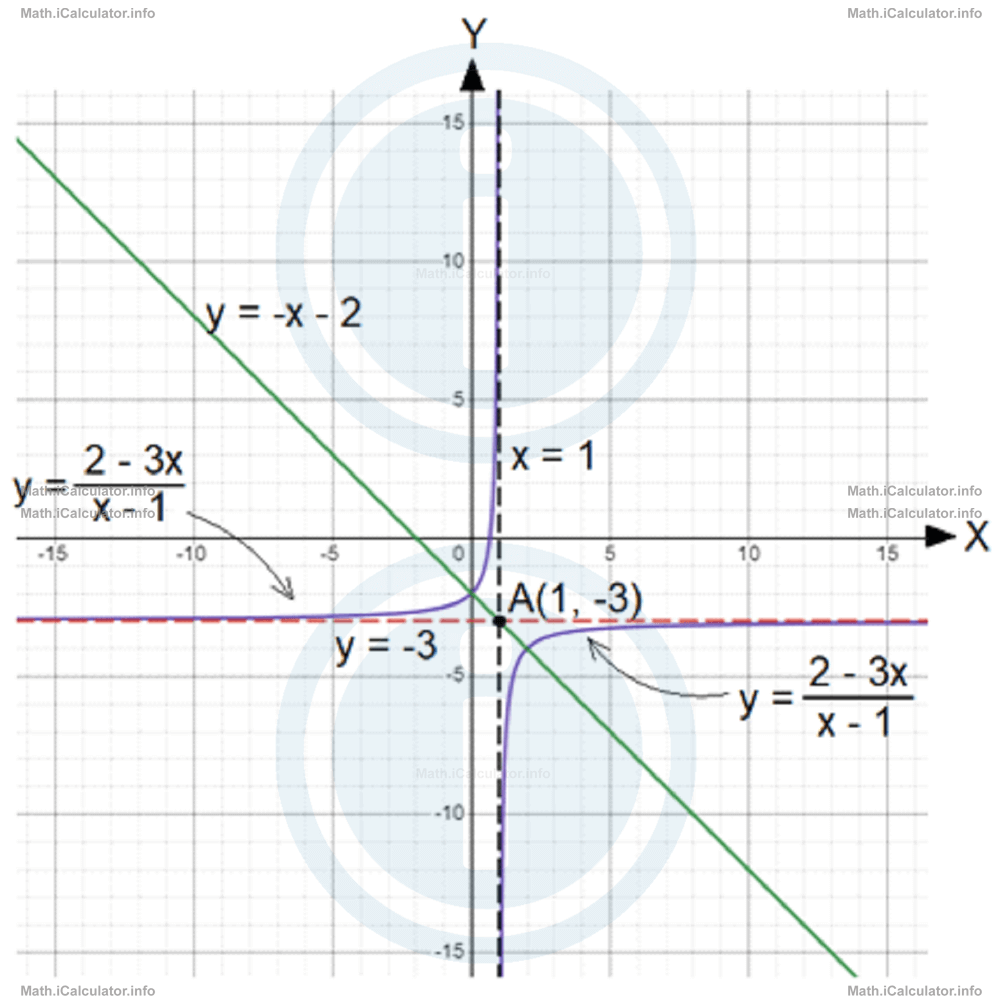Menu
Math Lesson 15.4.5 - Determining the Equation of the Symmetry Line of a Reciprocal Graph
Please provide a rating, it takes seconds and helps us to keep this resource free for all to use
Welcome to our Math lesson on Determining the Equation of the Symmetry Line of a Reciprocal Graph, this is the fifth lesson of our suite of math lessons covering the topic of Reciprocal Graphs, you can find links to the other lessons within this tutorial and access additional Math learning resources below this lesson.
Determining the Equation of the Symmetry Line of a Reciprocal Graph
Now that you know more on the asymptotes, let's use them to determine the equation of the symmetry line of a reciprocal graph mentioned earlier in this tutorial. We said that the symmetry line of the simplest form of the reciprocal function y = 1/x is y = x. The function y = 1/x on the other hand is a subset of a larger family of reciprocal functions given by the formula y = a/x. Therefore, nothing changes in the equation of the symmetry line for reciprocal equations of the form y = a/x; they still have y = x as a symmetry line.
Given that the graph of a reciprocal function in the general form
is not inclined, rotated, enlarged or dwindled in respect to the function y = a/x (and therefore in respect to y = 1/x) but only displaced horizontally, vertically or both, it is obvious that the equation of the symmetry line will have the form
where c is a constant.
At the beginning of this tutorial, we said that if there is a negative sign preceding the coefficient a in the reciprocal function, the graphs lie in the second and the fourth quadrant. Therefore, the equation of the symmetry line will be
To determine the value of c (and therefore the equation of the symmetry line), we find the intercept of the two asymptotes, as it is a point of the symmetry line graph. It is clear that this intercept point is A(h, k), where h and k are the coefficients of the original reciprocal function that determine the asymptotes. Then, after substituting the values of h and k in the equation of the symmetry line, we find the value of c.
Example 8
Find the equation of the symmetry line of the graph of the reciprocal function
Solution 8
First, let's write the equation (function) in the form
Thus, we have
= -3x + 2/x - 1
= -3x + 3 - 1/x - 1
= -(3x - 3) - 1/x - 1
= -3(x - 1) - 1/x - 1
= -3(x - 1)/x - 1 - 1/x - 1
= -3 - 1/x - 1
= -1/(x - 1) - 3
= -1/(x - 1) - 3
In this way, we have a = -1, h = -1 and k = -3. Hence, the two asymptotes are x = 1 and y = -3. This means the intercept of the two asymptotes is at A(1, -3). Substituting this point in the the equation of the symmetry line
yields
-3 + 1 = c
c = -2
Hence, the symmetry line of the given reciprocal graph has the equation
Look at the figure below for confirmation of the above result.

You have reached the end of Math lesson 15.4.5 Determining the Equation of the Symmetry Line of a Reciprocal Graph. There are 5 lessons in this physics tutorial covering Reciprocal Graphs, you can access all the lessons from this tutorial below.
More Reciprocal Graphs Lessons and Learning Resources
Whats next?
Enjoy the "Determining the Equation of the Symmetry Line of a Reciprocal Graph" math lesson? People who liked the "Reciprocal Graphs lesson found the following resources useful:
- Symmetry Feedback. Helps other - Leave a rating for this symmetry (see below)
- Types of Graphs Math tutorial: Reciprocal Graphs. Read the Reciprocal Graphs math tutorial and build your math knowledge of Types of Graphs
- Types of Graphs Revision Notes: Reciprocal Graphs. Print the notes so you can revise the key points covered in the math tutorial for Reciprocal Graphs
- Types of Graphs Practice Questions: Reciprocal Graphs. Test and improve your knowledge of Reciprocal Graphs with example questins and answers
- Check your calculations for Types of Graphs questions with our excellent Types of Graphs calculators which contain full equations and calculations clearly displayed line by line. See the Types of Graphs Calculators by iCalculator™ below.
- Continuing learning types of graphs - read our next math tutorial: Exponential Graphs
Help others Learning Math just like you
Please provide a rating, it takes seconds and helps us to keep this resource free for all to use
We hope you found this Math tutorial "Reciprocal Graphs" useful. If you did it would be great if you could spare the time to rate this math tutorial (simply click on the number of stars that match your assessment of this math learning aide) and/or share on social media, this helps us identify popular tutorials and calculators and expand our free learning resources to support our users around the world have free access to expand their knowledge of math and other disciplines.